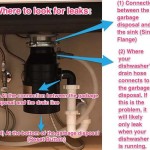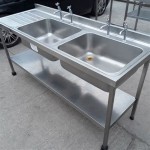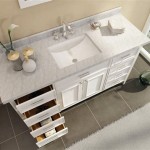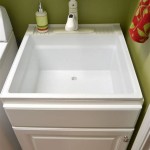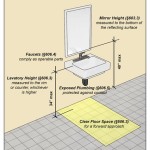Single Drain Kitchen Sink Plumbing Kit: A Comprehensive Guide
A single drain kitchen sink plumbing kit provides all the necessary components for connecting a kitchen sink with a single drain outlet to the drainpipe in a home. This kit offers a convenient solution for both new installations and replacement projects, ensuring a watertight and properly functioning drainage system. Understanding the individual components, installation process, and potential issues associated with these kits is crucial for homeowners and plumbing professionals alike.
The composition of a single drain kitchen sink plumbing kit typically includes several essential parts. These parts are designed to work together, facilitating the efficient removal of wastewater from the sink. A standard kit will generally consist of the following:
*Sink Basket Strainer: This sits within the sink drain opening and prevents large food particles and debris from entering the plumbing system. It usually features a removable basket or strainer for easy cleaning.
*Tailpiece: This is a short pipe section that connects directly to the bottom of the sink basket strainer. Its length can vary slightly depending on the sink's depth and the subsequent plumbing configuration.
*P-Trap: This is a U-shaped or P-shaped pipe designed to trap a small amount of water. This trapped water acts as a barrier, preventing sewer gases from entering the home through the drain.
*Drain Pipe or Extension: This pipe connects the P-trap to the main drainpipe in the wall or floor. It may be a straight pipe or have a slight angle, depending on the plumbing layout.
*Slip Nuts and Washers: These components are used to create watertight connections between the different pipes within the system. The slip nuts tighten around the pipes, compressing the washers to form the seal.
Plumber's Putty or Silicone Sealant: This is used to create a watertight seal between the sink flange and the sink basin. It prevents water from leaking around the edges of the drain assembly.Key Considerations Before Installation
Before embarking on the installation of a single drain kitchen sink plumbing kit, several crucial considerations should be addressed. Proper planning and preparation will contribute to a successful and leak-free installation. Here are some key points to keep in mind:
*Accurate Measurements: Obtain precise measurements of the distance between the sink drain outlet and the drainpipe connection. This will ensure that the tailpiece and drainpipe are the correct length. If necessary, you can use adjustable tailpieces or cut pipes to the desired length using a pipe cutter. Accuracy is paramount to avoid undue strain and potential leaks.
*Compatibility Check: Verify that the plumbing kit is compatible with the sink and drainpipe size. Sink drain outlets typically come in standardized sizes, but variations can occur. Ensure that the kit's components are suitable for the specific sink and drainpipe in your home. Check the diameter of the drainpipe to make sure the drain pipe or extension pipe that comes with the kit is a proper fit.
*Existing Plumbing Inspection: Examine the existing drainpipe and connections for any signs of damage, corrosion, or leaks. Address any existing issues before installing the new plumbing kit. Replacing corroded pipes or tightening loose connections will prevent future problems and ensure proper drainage.
*Gather Necessary Tools: Assemble all the required tools before starting the installation process. Essential tools include a pipe wrench, adjustable wrench, plumber's tape, a bucket to catch water, and a screwdriver. Having the right tools readily available will streamline the installation and prevent delays.
Step-by-Step Installation Process
The installation of a single drain kitchen sink plumbing kit involves a series of steps that require attention to detail and adherence to plumbing best practices. The following steps provide a general guide to the installation process:
Disassemble the Old Plumbing: If replacing an existing plumbing system, carefully disassemble the old pipes and connections. Use a pipe wrench or adjustable wrench to loosen slip nuts and disconnect the pipes. Place a bucket underneath to catch any residual water. Dispose of the old plumbing components responsibly.
Install the Sink Basket Strainer: Apply a bead of plumber's putty or silicone sealant around the underside of the sink basket strainer flange. Insert the strainer into the sink drain opening from above. From underneath the sink, attach the rubber gasket, friction ring, and mounting nut to the strainer body. Tighten the mounting nut firmly, ensuring a watertight seal. Remove any excess plumber's putty or silicone sealant.
Attach the Tailpiece: Connect the tailpiece to the bottom of the sink basket strainer assembly. Slide a slip nut and washer onto the tailpiece. Insert the tailpiece into the strainer outlet and tighten the slip nut securely. Ensure that the connection is snug but not overtightened.
Assemble the P-Trap: Connect the P-trap to the bottom of the tailpiece. Slide a slip nut and washer onto both ends of the P-trap. Insert the tailpiece into one end of the P-trap and the drainpipe into the other end. Tighten the slip nuts securely, ensuring that the P-trap is aligned properly.
Connect to the Drainpipe: Connect the drainpipe or extension to the P-trap. Slide a slip nut and washer onto the drainpipe. Insert the drainpipe into the outlet of the P-trap and tighten the slip nut securely. If necessary, cut the drainpipe to the appropriate length using a pipe cutter. Ensure that the drainpipe aligns with the main drainpipe in the wall or floor.
Secure All Connections: Double-check all connections to ensure that they are tight and leak-free. Use a pipe wrench or adjustable wrench to tighten the slip nuts further, if necessary. However, avoid overtightening, as this can damage the pipes or connections.
Test for Leaks: Run water into the sink and check for any leaks around the connections. Carefully inspect all joints and seams for any signs of water seepage. If leaks are detected, tighten the slip nuts further or disassemble the connection and reapply plumber's putty or silicone sealant.
Common Problems and Solutions
Even with careful installation, issues can sometimes arise with single drain kitchen sink plumbing kits. Understanding common problems and their solutions can help in troubleshooting and resolving potential issues.
*Leaks at Connections: Leaks at the slip nut connections are a common issue. This can be caused by loose slip nuts, damaged washers, or improper alignment of the pipes. Tightening the slip nuts further may resolve the issue. If the problem persists, disassemble the connection, inspect the washer for damage, and reapply plumber's putty or silicone sealant. Ensure that the pipes are properly aligned before reassembling the connection.
*Clogged Drain: A clogged drain can be caused by an accumulation of food debris, grease, or other materials. To clear a clog, try using a plunger or a drain snake. Chemical drain cleaners can also be used, but follow the manufacturer's instructions carefully. For persistent clogs, it may be necessary to disassemble the plumbing and manually remove the obstruction.
*Sewer Gas Odors: Sewer gas odors emanating from the drain can indicate a problem with the P-trap. The P-trap may be dry due to infrequent use, allowing sewer gases to escape. Running water into the sink for a few minutes will replenish the water in the P-trap and eliminate the odor. If the odor persists, the P-trap may be cracked or damaged and require replacement.
*Slow Drainage: Slow drainage can be caused by a partial blockage in the drainpipe or a venting issue. Check for any obstructions in the drainpipe and remove them. Ensure that the drainpipe is properly vented to allow air to enter the system and facilitate drainage. If the problem persists, consult a plumbing professional.
Regular maintenance of the single drain kitchen sink plumbing system can help prevent problems and extend its lifespan. Flushing the drain with hot water periodically can help remove grease and debris. Avoid pouring grease or oil down the drain, as this can contribute to clogs. Regularly inspect the plumbing for leaks and address any issues promptly. These preventative measures can help ensure a properly functioning and trouble-free drainage system.
Choosing the Right Plumbing Kit
Selecting the appropriate single drain kitchen sink plumbing kit is essential for ensuring a successful installation and long-term performance. Consider the following factors when choosing a plumbing kit:
*Material: Plumbing kits are typically made of PVC, ABS, or metal. PVC and ABS are lightweight and corrosion-resistant, while metal kits offer greater durability. Choose a material that is suitable for your specific needs and budget.
*Size: Ensure that the kit is the correct size for your sink and drainpipe. Check the diameter of the drain outlet and drainpipe to ensure compatibility. Select a kit with components that are appropriately sized for your plumbing system.
*Features: Some plumbing kits offer additional features, such as adjustable tailpieces, flexible drainpipes, or built-in air admittance valves. These features can simplify the installation process and improve the performance of the plumbing system. Consider whether these features are necessary for your specific needs.
*Brand Reputation: Choose a plumbing kit from a reputable manufacturer with a proven track record of quality and reliability. Read reviews and compare different brands before making a purchase.
Benefits of Using a Complete Kit
Using a complete single drain kitchen sink plumbing kit offers several advantages compared to purchasing individual components separately. These benefits can save time, effort, and potentially money.
*Convenience: A complete kit provides all the necessary components in one package, eliminating the need to source individual parts. This saves time and effort and ensures that all the components are compatible.
*Cost-Effectiveness: Purchasing a complete kit is often more cost-effective than buying individual components separately. Manufacturers typically offer discounts on bundled items, resulting in overall cost savings.
*Simplified Installation: A complete kit includes detailed instructions that guide the installation process step-by-step. This can simplify the installation and reduce the risk of errors.
*Guaranteed Compatibility: A complete kit ensures that all the components are designed to work together seamlessly. This eliminates the risk of incompatibility issues and ensures a proper fit.
By properly understanding the components, installation process, potential issues, and selection criteria associated with single drain kitchen sink plumbing kits, homeowners and plumbing professionals can ensure a functional and leak-free kitchen drainage system. Regular maintenance and prompt attention to any problems will further contribute to the longevity and efficiency of the plumbing system.

Snappytrap 1 2 In All One Drain Kit For Single Bowl Kitchen Sinks Bar And Utility Dk 100 The Home

Snappytrap 1 2 In All One Drain Kit For Single Bowl Kitchen Sinks Bar And Utility

Franke Siphon Single Bowl Plumbing Kit 112 0059 946

6480 Perrin Rowe Single Bowl Kitchen Sink Waste Kit

Vellamo Space Saving Single Bowl Plumbing Kit Tap Warehouse

Mcalpine Plumbing Kit For Single Bowl Kitchen Sinks Space Saving Ssk1

Spazio Plumbing Kit Single Kitchen Accessories Designs Nz Archant

Floplast Tw472 White Single Bowl Sink Kit 40mm Wickes Co Uk

Snappytrap Snappy Trap Drain Kit Single Bowl Kitchen Sinks 1 2 In P Black Plastic Dk 100 Lw At Com

Multi Fit Single Bowl Sink Waste Kit Space Saving 1 2 40mm P Trap With

